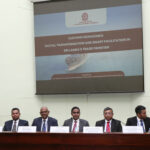
By: Geoff Spooner
On the 21st of April 2006 Geoff Spooner, the son of Commander Spooner RN Rtd, wrote to me with a fascinating account of the events leading to the sinking of the Admiralty Floating Dock 23 and the resulting damage to the HMS Valiant.
At that time Commander Spooner was Executive Chief Engineering officer in HMS Renown and was present at the time of the event. I requested permission from Geoff to publish his letter, but he requested more time to discuss the incident with his father and to provide a more definitive and accurate account of what really happened. Finally on the 27th of November 2007 Geoff corresponded with me again and provided the following, quite amazing, description of the AFD26 sinking as narrated by Commander Spooner RN Rtd. DiveSriLanka.com is very grateful to both Geoff Spooner and Commander Spooner RN Rtd for the effort taken to shed light to this very significant event in the naval history of Sri Lanka and granting us permission to publish the story.

Source: http://www.divesrilanka.com/DSTrincoAFD23-2.html

If I may, I would like to make those additions and corrections to the account of events surrounding the sinking of the Admiralty Floating Dock 23 on August 8, 1944. My father is still strongly independent and will be 97 this December 2007. He has given you his blessing if you wish to publish, or recount, or not, his recollection of events leading up to the sinking of the Admiralty Floating Dock 26 and the events that occurred during and after that fateful night. The events and vessels that sank prior to the sinking of the Admiralty floating dock 26 are probably of no interest to you as they occurred in the convoy from Durban to Trincomalee. The Khedive Ismael for example, a troop transport, carrying nurses and medical staff, was torpedoed by the Japanese submarine I-27, and sank in waters that you would not be diving.
Above left is a picture of HMS Valiant in dry dock. Apparently, it was taken in 1944 during the time that she was part of the East India Fleet by a Naval rating serving in her. However, it may or may not be the Floating Dock in Trincomalee. If you can identify the surrounding landscape from the known position of the sunken dock, then maybe you can verify that this may very well be a rare photograph of the dock not long before it sank. I used Google Earth satellite imagery and believed that this picture is more likely to have been taken in the Port of Durban.
The photo below, taken by a reconnaissance CV-3 plane from the USS Saratoga on 12th May 1944, shows HMS Renown – centre, Richelieu L and Valiant R. All four ships were in Trincomalee while Valiant was to be dry docked for repairs and anti-fouling. (NOT as previously mentioned from a collision with HMS Warspite. That was in World War I!) Also in port that night was HMS Queen Elizabeth, sister ship to Valiant.
As my father recalls more clearly, it was the then Vice Admiral Arthur John Power to whom he was reporting that night (who’s flagship was HMS Renown) and for whom he had the responsibility of escorting to and from the dry dock and assessing damage and possible salvage. Because HMS Renown was due to use the dock for anti-fouling, my father had previously boarded the floating dock to familiarize himself with all of the controls and operational procedures.
On the night of August 8th, 1944, by the general list of the Dock, it was apparent that all was not well. Upon boarding the dock with the Vice Admiral, my father went straight to the control room only to find no one at the controls. He immediately realized that the sequence of pumping out the ballast tanks was inappropriate for HMS Valiant, being short, weighted amidships but more importantly, being fully loaded with ordnance. Apparently, the operators did know that HMS Valiant carried most of her weight amidships but did not know that she had a full load of ordnance. They therefore began by pumping out the mid dock tanks first. Too much weight fore and aft and too much lift amidships caused the dock to break its back upwards. Recommendations were made but too late to make any difference.
After having assessed the situation, Commander Spooner reported to the admiral, (both of whom were on the dock), saying, “If you want to leave with dignity, I think we should leave now Sir”, to which the Admiral responded, “Nonsense Spooner, nonsense” and proceeded to walk on the dock away from the launch. A few moments later, the dock began to list more heavily. The Admiral bumped into Commander Spooner on his way back to the launch. They both promptly boarded the launch and as the Admiral stepped onboard, there was a loud crack as the dry dock broke its back.
HMS Valiant apparently still had a head of steam and although her stern gear and stern hull plating were seriously damaged, the ships company was able to save the vessel as the floating dock continued to sink. The damage however was too severe, and she never saw active service again. As far as the Dock is concerned, my father’s recollection of the events and conversation with the then Vice Admiral are correct. There is a small addendum with regard to one of the giant cranes that ran on railway tracks aboard the floating dock. After my father left to return to HMS Renown the ailing dock was only visible by the searchlights aimed at it from the surrounding destroyers. At one point after the dock had broken it’s back, the angle of the deck was such that one of the dock’s giant cranes began rolling down the tracks picking up speed until it ran off the tracks and into the water.
I understand that there was a salvage effort by a French company around 1968. It sounded as though the dock had been completely salvaged although that doesn’t ring quite true as I also recently read somewhere that it is forbidden to dive on the wreck or site? Maybe you can shine some light on the subject? In any case, there may still be a crane nearby the site? My father does have quite a collection of photographs of his Naval years from Scapa Flow to the Yangtze Chiang. There may even be one or two from Trincomalee. I shall look through them and let you know.
Just as a footnote, I noticed that by using Google Earth Satellite imagery, it is possible to make out a couple of wrecks within the harbor at Trincomalee.
WAR EXPERIENCES: DRY DOCK IN CEYLON by R.G. Lapham
It was midnight and I was sleeping on the upper deck in my hammock when the Tannoy blared out “Away Sea Boats Crew, Away Cutter, etc. —–Away Captains Boat Crew”. At that point with all the ships’ boats called out, I knew that something was wrong.
I was serving, as an Electrical Artificer, on a Submarine Depot ship moored in Trincomalee Outer Harbour, which is in Ceylon (now Sri Lanka). Trincomalee was the Base Harbour for the Forward Attack Force of the Pacific Fleet in 1943. Our submarines were operating in the Malacca Straits for a month at a time and were also dropping off white-faced officers in canoes behind Japanese lines. When they returned from a Patrol, they went immediately to the rest camp in Diyatalawa, and after fumigating the “boat “, as the Submarines were called, the spare crew stripped the boat out and brought it into a suitable state for recommissioning.
I realized why the Officers were white faced when I happened to enter an upper cabin in which some Japanese prisoners of war were being held. They cringed into the corner of the room trying to get behind each other as I entered. I beat a hasty retreat with a sick feeling in my stomach. The spare crew was accommodated alongside in a Chinese riverboat called the Wu Chang. This riverboat had escaped from the Japs with refugees from the Japs and had included children.
I had become accustomed to the boats, coming in with the Jolly Roger flying from the conning tower, already updated with the different symbols for the various successful sinkings on that patrol, the deck crew would be lined up in their Submarine sweaters. Then it would come smartly alongside pass the wires across, tie up, and immediately the captain would appear in full dress uniform including dress sword, and come sharply aboard to make a report to the Flotilla Captain.
It was not always so happy a return, I recall a “Boat” returning without the forward gun turret, where on surfacing to attack a gunboat the gun turret and gun crew were both shot away. Then there was the occasional “Charioteer” seen as a bobbing head above the water. Previously during the preceding months, to our great surprise, a large floating dock had been towed out from UK in three parts, had been connected together, and was now accommodating the HMS Valiant for various servicing tasks. It was this, which had caused the panic, as the dry dock had started sinking, with the Valiant still in it.
I heard later that the Valiant had fortunately kept up a head of steam, and so had managed to escape from the dry dock with only slight damage to its propeller. However, it then had to limp home to UK, was refused passage through the Suez Canal, but eventually made it with a detour around the Cape.
There is a sequel to this story, I returned to work in Ceylon after the war, and was able to dive on the wreck of the Floating Dock. It was like new one of the towers still visible above the surface, as I dived the portable generator was visible still sitting on the upper deck, and the supports and ironwork which held the Valiant were in a tangled mess about 90 ft down at the bottom part of the dock.
INCIDENT AT TRINCOMALEE by Elizabeth Lister
In May 1943 Alec joined HMS Ganges, the shore-based training ship, as a boy cadet. He was seventeen years old. One day the Chief Mate told Alec and his friend that they were to go on a mission and would be back in about three months, but in fact it would be two and a half years before they returned to the UK. First of all they were sent to the Mediterranean where they remained from Sept 43 until April 44, after which they went to the Far East. He dictated to me the following incident which occurred off Trincomalee in Ceylon:
When I was transferred from the Mediterranean fleet to the Dutch East Indies fleet, I came on board HMS Wayland which was the Fleet Repair ship. My job was Bowman on the 45ft Cutter. There was also a Stern Bowman, Stoker and the leading hand who was the Coxswain. One night at about 2 a.m. we got a call on the tannoy: it was for boat crew at the gangway on the double. I then went onto the Cutter, and we cast off.
It was a very dark night, there were no lights and the leading hand said there had been a major incident. When we got close to a floating dock, I could see that it was at an angle of about 40 degrees. Inside the floating dock was a battleship. Later I learned that it was HMS Valiant, a 35-thousand-ton battleship. As we got to the dock, we could see there were a lot of Singhalese workmen, and they were in a panic. We came alongside and picked them up. It was very dangerous as the whole dock and the ship could have turned over. We laid off to see what was going to happen. After about two hours the dock engineers started to stabilise the dock. We were told to take our Singhalese to the jetty. We then went back to the floating dock, picked up any more workmen and at about 6 a.m. we were told there was no more danger, and we went back to HMS Wayland. The Commander-in-Chief of the Dutch East Indies fleet sent a signal to our captain, Lord Carson, expressing his deep gratitude. We then found out that the Valiant had to be taken away to Colombo and were later told that she had broken her back. This incident had to be kept very quiet as both the floating dock and HMS Valiant had been badly damaged, and in fact she never saw any further operational action. I don’t know the reason for the dock tilting but I think it was something to do with the instruments. As a result of this incident, I was allowed to go on transfer to HMS Cumberland, where I went on a big bombardment exercise against Sabang, an island in the Straits of Malacca, this being one of the biggest operations in the Dutch East Indies fleet. I remained in the Far East from 1944 until 1946 when I was demobbed.
Sources: https://www.bbc.co.uk/history/ww2peopleswar/stories/27/a1980227.shtml, https://www.bbc.co.uk/history/ww2peopleswar/stories/76/a8088276.shtml and http://www.divesrilanka.com/DSTrincoAFD23.html











